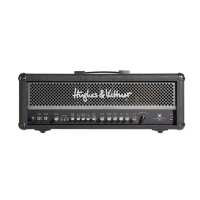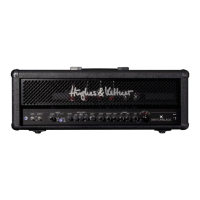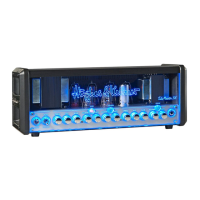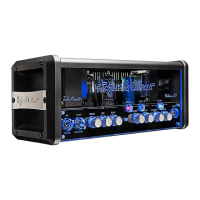9
english
7 MIDI Control and Programming
7.1 FSM 432
The included Hughes & Kettner® FSM 432 MIDI board is a remote control
serving to select the 128 memory slots conveniently arranged in 32 Banks of four
presets each. You can easily configure setups any way you wish, say by assigning
the four presets of a bank to a song. Section 6.4.1 explains how to properly
connect the FSM 432.
7.1.1 PRESET A B C D
Presets within a bank can be activated directly, that is, switching from A to B
within the same bank occurs immediately. The LED above the A,B,C,D buttons
indicates the preset.
7.1.2 BANK UP/DOWN
If you want to call up a preset in another bank, you can select the bank via UP
and DOWN while continuing to play using the current preset. The number of
the bank is indicated in the display, and it flashes until you select a preset via
A,B,C,D. Not until then will SWITCHBLADE TSC load the new preset.
DIRECT MODE is available if you wish to trigger a direct program change via
bank Up/Down. In this mode, the FSM 432 will not wait for your input, instead
switching immediately, for example, from preset B in bank 16 to preset B in bank
17 (UP) bank or 15 (DOWN). Direct Mode is activated as follows:
• Press and hold TAP, and then press PRESET A
• First release PRESET A, and then TAP: The decimal point in the display lights up
Follow the same sequence to deactivate DIRECT MODE. Volatile rather than
permanent, DIRECT MODE is automatically deactivated when you power
SWITCHBLADE TSC down!
7.1.3 TAP
The TAP function gives you a very fast and convenient option for changing the
Delay’s TIME parameter. TAP comes in particularly handy on stage: Simply tap
your foot on the TAP button in time with the groove to match delay time to the
tempo. The effect adopts the new time after the second tap. The TAP LED flashes
for about five seconds in time with the beat to give you a visual indication of the
delay time.
Note: The TAP function works only when the DELAY is active. If the DELAY
is off, the effect will not adopt your TAP tempo.
7.1.4 Switching External Devices via the FSM 432, Setting the MIDI Send Channel
If you wish to switch devices connected to SWITCHBLADE TSC MIDI THRU
– say, a MIDI effect device – using the FSM 432, ensure the effect device is set
to the FSM 432’s MIDI Channel or to OMNI. Consult the device’s manual for
more info.
To set the FSM 432’s MIDI Send Channel, proceed as follows:
• Turn SWITCHBLADE TSC on while pressing the FSM 432’s PRESET A
button. The display flashes.
• Release button A. Use UP/DOWN to view and set the MIDI Channel to a
number between 1 and 16.
• Quit and store by pressing the PRESET A button.
Caution: If SWITCHBLADE TSC and FSM 432 are not set to the same MIDI
channel, the amp will not respond to program changes! Activating OMNI solves
the problem in the event of an “emergency.” See chapter 7.2 to learn more.
Note: If an external effect device is connected to MIDI THRU and you want
to switch SWITCHBLADE TSC and the effect device simultaneously with the
same program change command, you must configure SWITCHBLADE TSC’s
Store function and program this device accordingly.
Note: The table below should be big help if you wish to switch the Presets of a
device connected to the MIDI THRU directly via the FSM 432. It shows the
program changes sent by the bank/preset combination. Please bear in mind that
some MIDI devices switch program 1 via program change command 0. If this is
the case with your outboard gear, simply add a 1 to each value indicated in this
table to activate the desired program.
Bank
Preset
Programchange
Number
Bank
Preset
Programchange
Number
Bank
Preset
Programchange
Number
Bank
Preset
Programchange
Number
1 A 0 9 A 32 17 A 64 25 A 96
1 B 1 9 B 33 17 B 65 25 B 97
1 C 2 9 C 34 17 C 66 25 C 98
1 D 3 9 D 35 17 D 67 25 D 99
2 A 4 10 A 36 18 A 68 26 A 100
2 B 5 10 B 37 18 B 69 26 B 101
2 C 6 10 C 38 18 C 70 26 C 102
2 D 7 10 D 39 18 D 71 26 D 103
3 A 8 11 A 40 19 A 72 27 A 104
3 B 9 11 B 41 19 B 73 27 B 105
3 C 10 11 C 42 19 C 74 27 C 106
3 D 11 11 D 43 19 D 75 27 D 107
4 A 12 12 A 44 20 A 76 28 A 108
4 B 13 12 B 45 20 B 77 28 B 109
4 C 14 12 C 46 20 C 78 28 C 110
4 D 15 12 D 47 20 D 79 28 D 111
5 A 16 13 A 48 21 A 80 29 A 112
5 B 17 13 B 49 21 B 81 29 B 113
5 C 18 13 C 50 21 C 82 29 C 114
5 D 19 13 D 51 21 D 83 29 D 115
6 A 20 14 A 52 22 A 84 30 A 116
6 B 21 14 B 53 22 B 85 30 B 117
6 C 22 14 C 54 22 C 86 30 C 118
6 D 23 14 D 55 22 D 87 30 D 119
7 A 24 15 A 56 23 A 88 31 A 120
7 B 25 15 B 57 23 B 89 31 B 121
7 C 26 15 C 58 23 C 90 31 C 122
7 D 27 15 D 59 23 D 91 31 D 123
8 A 28 16 A 60 24 A 92 32 A 124
8 B 29 16 B 61 24 B 93 32 B 125
8 C 30 16 C 62 24 C 94 32 C 126
8 D 31 16 D 63 24 D 95 32 D 127
7.2 Setting SWITCHBLADE TSC’s MIDI Channel and Switching OMNI ON/OFF
Press the SERIAL button longer than two seconds when SWITCHBLADE TSC
is in normal operating mode, and the ORIGINAL VALUE LED will start flashing.
This assigns special programming functions to the amp’s LEDs and buttons:
FX ON: Now serves as a +1/UP button for setting the MIDI Channel.
Serial: Now serves as a -1/DOWN button for setting the MIDI Channel.
Store: OMNI ON/OFF switches. If the STORE button (OMNI On) lights up,
SWITCHBLADE TSC responds to all incoming program changes, irrespective
of the MIDI Channel over which they are sent. If the light on the button is
extinguished (OMNI OFF), it responds only to messages sent via the defined
MIDI Channel.

